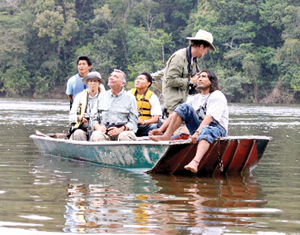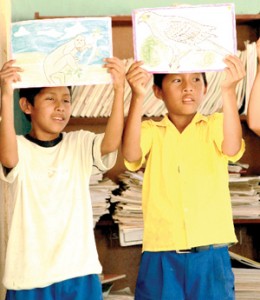Latest update February 7th, 2025 2:57 PM
Latest News
- AFC Leader, Nigel Hughes says he welcomes any investigation into lands he acquired
- Pres. Ali defends Jagdeo’s attacks on critics
- VP Jagdeo tries to compare 75 acres of jungle lands Nigel Hughes wants to acquire with 35 acres of prime city lands sold to Ed Ahmad and others
- Greaves tells Govt ‘clean money’ used to acquire New York properties- Jagdeo
- Trump says Israel would hand Gaza to the US after fighting is over
Guyana Tour Reveals Harpy Eagles, endless rainforest, and authentic Indigenous cultures
Apr 08, 2010 News
It was well past noon and the group had already been huddled 80 feet beneath a Harpy Eagle’s nest for more than an hour when it started rain but yet they were not ready to leave. “We’re not ready to dip on the Harpy” they said, meaning miss the chance to see a rare bird.
The nest appeared empty, but the more the guide Gary talked about seeing the adult female and juvenile Harpies at the nest two days ago, the more the group wanted to wait.
So everyone stood at the base of the tree for two hours –half of it in pouring rain – staring at an impressive (albeit empty) nest, because the Harpy Eagle is a rare ‘mega-find’ that everyone wanted to see.
For 11 days in March, this group of bird watching tour operators, journalists, and photographers from North America and the UK poked around Guyana’s rainforests and savannahs in search of birds, mammals, and local culture on a tourism product familiarization (fam) trip organized by the Guyana Sustainable Tourism Initiative
(GSTI), a joint project of the Guyana Tourism Authority (GTA) and the United States Agency for International Development / Guyana Trade and Investment Support (USAID/GTIS) project.
Reflecting on the journey, owner and founder of Nature Travel Specialists, Andrew Haffenden said, “I felt that all the places and guides are making an exceptional and personal effort to preserve and promote Guyana’s nature and people, which forms a very solid base.
I’m sure the others [on the fam] agree that few places we visit have the same effect in this way as Guyana, and it’s quite refreshing and encouraging. In turn, it makes others, such as our group; want to assist all they can.”
The fam trips have been a key part of the GSTI strategy to market and promote Guyana on the international stage.
There are many beneficial results to providing a first-hand experience of Guyana to tour operators and media, including increased international recognition and a growing number of visitor arrivals.
As Mr. Haffenden noted, it also allows local tourism suppliers to receive constructive feedback from experts who sell and promote trips around the world.
The participants on this fam provided many excellent recommendations that will help improve Guyana’s tourism products for additional markets beyond birding, including community-based, general nature, conservation based, research-based, adventure, and educational tourism.
The GSTI will be working with Guyana’s tourism suppliers to increase and improve guide training, product development, transportation logistics, and ecotourism standards.
With no Harpy Eagles in sight on the group’s first attempt, they finally agreed to leave the forest after hearing of a different active nest near Rewa village, another stop on the itinerary that included Georgetown, Iwokrama River Lodge, Atta Rainforest Lodge and Iwokrama Canopy Walkway, Surama Eco-Lodge, Rock View Lodge, Karanambu Ranch, Lethem and Kaieteur Falls.
The birding was fantastic throughout – by the end of the trip the group had identified nearly 360 different species of birds (including the Harpy Eagle near Rewa). General
Manager of Andean Birding, Charlie Vogt, has birded extensively in South America but still managed to add 65 new species (or ‘lifers’ in birding lingo) to his list – a “significant” achievement.
Mr. Vogt said that he “was blown away by the vast pristine rainforests [in Guyana],” adding that he “can’t wait to sell this tour and have another chance to return to this magical place.”
Due credit for the magic goes to the appearance of the day-glow orange Guianan Cock-of-the-Rock at Kaieteur Falls and Iwokrama, and the bizarre mooing and Dracula like poses of the Capuchin bird.
And magic or not, various Macaws, Toucans, Woodpeckers, and Hawks lit up the group’s ‘bins’ (because ‘binoculars’ is too long) so often the birders began calling them ‘Trash Birds’ (‘TBs’ for short), or locally common birds.
It sounds bad, but the birding experts said having Macaws and Toucans as trash birds is a good thing.
Every now and then, the birders even managed to get excited over some non-feathered species like Kinkajou, Red-rumped Agouti, Tyra, Capybara, Giant River Otter, Black Caiman, and Red Howler, Spider, Capuchin, and Squirrel Monkeys.
The Jaguar remained elusive but the guides did manage to find very fresh tracks – bins not even necessary. Cultural presentations at Rewa and Surama villages also made a big impact on the group.
When asked to list Guyana’s strengths in tourism, Pelin Karaca of Holbrook Travel said, “Birds, pristine rainforest, and community tourism potential.” About the community-run ecolodges at Rewa, Ms. Karaca said, “Rewa is a gem. This place is a diamond in the rough.”
Dr. Steve Banner, director of Wildlife & Wilderness, was also touched by Guyana. During the trip, Dr. Banner wrote a post on his blog: “There are such good numbers of key indicator species such as Red-throated Caracaras and many Toucans…So will we sell Guyana holidays in the near future? Most definitely yes, but it is a country for the more adventurous and keen naturalists or bird watcher. For the latter, it is terrific.”
For Tim Appleton, the originator and co-founder of British Bird watching Fair, this trip marked his return to Guyana after being on a GSTI fam trip in 2007.
Mr. Appleton said that “the trip was an outstanding success and I predict it will result in lots of interest from media and tour companies alike.”
As for progress in Guyana’s industry, Mr. Appleton said it has come on in “leaps and bounds” in the areas of guide training, birding knowledge, and some lodge improvements.
Multi-faceted Karen Strauss – her titles include journalist, photographer, editor, coordinator of the San Diego Bird Festival, and trip leader for Avian Adventures – listed
Guyana’s selling points as, “birds, nature, river travel, pristine rainforest, and interaction with Amerindians and other cultures.”
Ms. Strauss is creating a bird watching trip to Guyana through the San Diego Audubon Society and will be using her photos and videos to promote Guyana.
Freelance travel writer and photographer, Eric Lindberg, found Guyana to be a “wild and pristine country where you can experience a landscape mostly untouched by humans. Being relatively undiscovered makes this an attractive place for travellers wanting a unique experience.”
Of the stories he plans to write, Mr. Lindberg says “Sustainable tourism is a significant angle in the Guyana story…this is what will set Guyana apart from other South American countries with rainforests.”
Bill Thompson, III, Editor of Bird Watcher’s Digest (which will feature Guyana in a full-length article in their July/August 2010 issue), enjoyed Guyana’s intact rainforest, the plethora of birds, and endless photo opportunities.
As a writer and speaker, Mr. Thompson is good at offering concise counsel, and for Guyana he says, “Keep the rainforest and all that lives in it. Fight against anything that will ruin this special quality of Guyana.”
The GSTI familiarization tours would not be possible if local tourism suppliers were not pledging their full support. For this program, GTA-USAID/GTIS is grateful for the generous contributions from Wilderness Explorers, Cara Lodge, Guyana Pegasus, Surama Eco-Lodge, Iwokrama International Centre, Atta Rainforest Lodge, Rock View Lodge, Karanambu Ranch, Community and Tourism Services (CATS), Rewa village, and Savannah Inn.
Share this:
- Click to print (Opens in new window)
- Click to email a link to a friend (Opens in new window)
- Click to share on Facebook (Opens in new window)
- Click to share on WhatsApp (Opens in new window)
- Click to share on Twitter (Opens in new window)
- Click to share on Pinterest (Opens in new window)
- Click to share on Pocket (Opens in new window)
- Click to share on Tumblr (Opens in new window)
- Click to share on Reddit (Opens in new window)
- Click to share on LinkedIn (Opens in new window)
Related
Similar Articles

The Glenn Lall Show | February, 3rd, 2025
Follow on Tik Tok @Glennlall
THE BLUNT OF THE DAY

Sports
Feb 07, 2025
2025 CWI Regional 4-Day Championships Round 2…GHE vs. CCC Day 2 -Eagles (1st innings 166-6, Imlach 58*) trail CCC by 209 runs Kaieteur Sports- Combined Campuses and Colleges (CCC) owned Day 2...Features/Columnists
What Guyanese leaders can learn from Donald Trump
Peeping Tom… Kaieteur News-There is little dispute that Donald Trump knows how to make an entrance. He does so without... more
OAS Secretary General Election and renewed OAS Consensus
Antiguan Barbudan Ambassador to the United States, Sir Ronald Sanders By Sir Ronald Sanders Kaieteur News- The upcoming election... more
Publisher’s Note
Freedom of speech is our core value at Kaieteur News. If the letter/e-mail you sent was not published, and you believe that its contents were not libellous, let us know, please contact us by phone or email.
Feel free to send us your comments and/or criticisms.
Contact: 624-6456; 225-8452; 225-8458; 225-8463; 225-8465; 225-8473 or 225-8491.
Or by Email: [email protected] / [email protected]
Weekend Cartoon

















